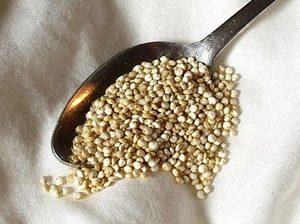Quinoa, pronounced KEEN-WAH, is a seed that has taken American health-nuts by storm in recent months. But what is quinoa, why is it hailed by nutritionists, and how can we incorporate it into our diets?
What is Quinoa?
Quinoa is a seed that originated in Andes region of South America. The Incans, knowing its nutritional value, hailed quinoa as “the mother of all grains. Quinoa grows in large leafy bushes, but the part we eat is actually the seed of the plant. It is also gluten-free, which makes it a great option for those with Celiac’s disease.
Nutritional Breakdown of Quinoa
Quinoa really is the mother of all grains (although it is a seed, not a grain). The nutritional content of quinoa is really quite remarkable. It is known as a “complete protein”, which means that quinoa contains all of the essential amino acids (these essential amino acids are: phenylalanine, valine, threonine, tryptophan, isoleucine, methionine, leucine, and lysine). Essential” amino acids are essential because humans cannot synthesize them in our bodies, and thus must rely on outside sources for them. Most animal products, such as meat, poultry, fish, and eggs provide complete protein; as such, quinoa is really a great food for vegetarians and vegans who often struggle to find complete proteins. With 22 grams of protein per cup of quinoa, it is a nutritional wonder and really should not be omitted from the diet.
Quinoa also provides a good amount of fiber per serving. ¼.5 grams of fiber per cup of brown rice, 4 grams of fiber per cup of oatmeal, and 6 grams of fiber per cup of whole wheat spaghetti, you really can see the nutritional value of quinoa!
Not only does quinoa contain high amounts of complete protein and fiber, it also contains high levels of magnesium, phosphorous, and iron. With all of these nutritional attributes to a single quinoa seed, why not try to incorporate it into your diet?
Eating Quinoa
There are different kinds of quinoa that you’ll find to purchase in the market, all with the same great attributes described above. Both red and off-white are readily available at health food stores. Quinoa flour is also available.
Before cooking with the quinoa seed (not the flour), be sure to rinse it thoroughly-it can taste very bitter if this is not done. As the seeds are being rinsed, gently rub them against the strainer to remove the “saponin” from the seed. For basic cooking, boil 1 cup of water in a small saucepan and then add ½ up of rinsed quinoa. Bring it back to a boil and then reduce to a simmer while covering the saucepan. Simmer for about 10-15 minutes, or until all of the water has been absorbed.
Quinoa can be eaten as a replacement of rice or other grains that you eat daily-adding a bit of soy sauce or other flavoring is good because the quinoa does not have a strong taste on its own.
Quinoa flour is wonderful in baked goods-and it definitely improves the nutritional content of many deserts. You can easily replace 10-15% of the all purpose or pastry flour called for in a recipe with quinoa flower without noticing a difference. Quinoa flour can easily replace oat or soy flour in cookies or brownies.
See the supporting links for different recipes and more information on quinoa’s nutritional content and history.



